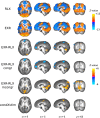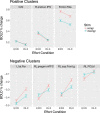Voluntary modulation of mental effort investment: an fMRI study
- PMID: 29222423
- PMCID: PMC5722925
- DOI: 10.1038/s41598-017-17519-3
Voluntary modulation of mental effort investment: an fMRI study
Abstract
Mental effort is a common phenomenological construct deeply linked to volition and self-control. While it is often assumed that the amount of exertion invested in a task can be voluntarily regulated, the neural bases of such faculty and its behavioural effects are yet insufficiently understood. In this study, we investigated how the instructions to execute a demanding cognitive task either "with maximum exertion" or "as relaxed as possible" affected performance and brain activity. The maximum exertion condition, compared to relaxed execution, was associated with speeded motor responses without an accuracy trade-off, and an amplification of both task-related activations in dorsal frontoparietal and cerebellar regions, and task-related deactivations in default mode network (DMN) areas. Furthermore, the visual cue to engage maximum effort triggered an anticipatory widespread increase of activity in attentional, sensory and executive regions, with its peak in the brain stem reticular activating system. Across individuals, this surge of activity in the brain stem, but also in medial wall cortical regions projecting to the adrenal medulla, positively correlated with increases in heart rate, suggesting that the intention to willfully modulate invested effort involves mechanisms related to catecholaminergic transmission and a suppression of DMN activity in favor of externally-directed attentional processes.
Conflict of interest statement
The authors declare that they have no competing interests.
Figures















References
-
- Paas F, Tuovinen J, van Merrienboer J, Aubteen Darabi A. A motivational perspective on the relation between mental effort and performance: Optimizing learner involvement in instruction. Educational Technology Research and Development. 2005;53:25–34. doi: 10.1007/BF02504795. - DOI
Publication types
MeSH terms
LinkOut - more resources
Full Text Sources
Other Literature Sources
Medical

